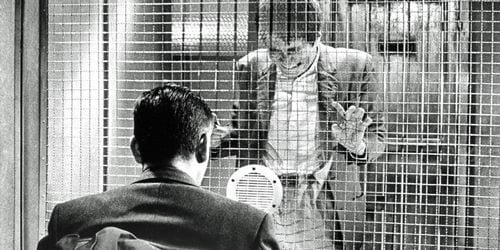
Akira Kurosawa is widely renowned as the director of classic Japanese period pieces like The Seven Samurai, Throne of Blood, Rashomon, and many others. In 1963, he switched gears and created a stunning contemporary thriller that crossed a variety of genres. Adapted from the novel King’s Ransom by Ed McBain, High and Low marks a daring attempt to tell an epic story of rich businessmen, determined cops, and the low-end criminals and drug addicts struggling to survive. It’s highly ambitious and has a few dry spots, but the overall effect remains with you for a very long time.
The story focuses on the kidnapping attempt of the son of Kingo Gondo (Toshiru Mifune), who receives a huge ransom request from the captors. In actuality, they accidentally take the son of Gondo’s chauffeur Aoki (Yutaka Sada), instead. The ransom offer remains the same, and this puts Gondo in an even trickier situation. If he pays the kidnappers, it will ruin his business career and leave the wealthy man with a much different financial life. If he refuses, however, he would likely still lose his career when the public discovered he let a boy die. Gondo is not an evil man, so he also faces a crisis of morality and won’t easily sentence Aoki’s son to death.
High and Low has a three-act structure with each segment falling inside a different film genre. The opening segment lasts nearly an hour and presents the melodrama for Gondo as he deals first with the possible loss of his son and then with a nasty ethical dilemma. The sequence pretty much takes place in one location, and Kurosawa creates a claustrophobic atmosphere. The kidnappers call several times, and Gondo tries to stay composed while his livelihood is threatened. Working with the cops to figure out the best approach, the tension is unrelenting as they prepare for their next move. This is the slowest part of the movie, and some filmmakers might rush through the set-up and get to the action. Kurosawa’s patience plays out as the film progresses because we’re engaged in each character’s story by that point.
The middle act is basically a police procedural as we watch them run down every lead to the kidnappers’ whereabouts. The strong-willed Chief Detective Tokura (Tatsuya Nakadai) leads the investigation and takes a measured approach to each action. There’s no surprising twist that solves the case, and the cops must stay diligent to pull together all the clues and recover the ransom money. Meanwhile, Aoki pushes his son to remember the details of the kidnapping. His guilt for the loss of Gondo’s business is strong and drives him to fervently seek out the culprit’s location.
The final (and best) act follows the police as they close in on the likely suspect (Tsutomu Yamazaki) while he tries to save his skin. The lengthy sequence at a local dance hangout is masterfully shot and perfectly shows the cops’ patience to grab him at the right time. While he tries to buy drugs in clever fashion, they stay focused on everything that’s happening at this venue. The sequence contains virtually no dialogue and long takes, and that approach is captivating. This scene and earlier moments in the city slums contrast sharply with the clean interiors of Gondo’s elegant house. Kurosawa has taken us from the mansion on the hill right into the alleyways of the dark city.
This excellent Blu-ray release from The Criterion Collection includes an informative group of extras that provide details on both Kurosawa and this film. The highlight is a 37-minute documentary from the Toho Masterworks Series’ Akira Kurosawa: It Is Wonderful to Create feature. It offers interviews with the filmmaker and most of the key cast and crew members from this picture, including several camera men.
Another gem is the 30-minute episode of the Tetsuko’s Room talk show that includes a rare interview with Toshiro Mifune. Covering both his personal life and approach to acting, this light conversation is enjoyable without covering much fluff. There’s also a 19-minute interview with Tsutomu Yamazaki from 2008 that focuses on his role as the kidnapper. If that wasn’t enough, the feature-length commentary with Kurosawa scholar Stephen Prince gives even more valuable background. Finally, Criterion includes a few insightful essays with the text booklet.
High and Low shows Kurosawa at the top of his game in both the technical and creative sides of the production. Employing the effective use of multiple cameras, he shoots long takes and cuts between them during the scenes. This helps the actors to deliver top-notch work, and it shows across the board. Mifune is more restrained than usual as Gondo but brings a complexity to the successful businessman. This is not your typical mindless rich guy.
Kurosawa also presents a powerful social message without making it obvious. The story functions as an interesting crime drama on its own, and the larger themes of the wide class divide make it even more compelling. It works on multiple levels and should only get better with repeat viewings.

![Call for Papers: All Things Reconsidered [MUSIC] May-August 2024](https://www.popmatters.com/wp-content/uploads/2024/04/all-things-reconsidered-call-music-may-2024-720x380.jpg)



